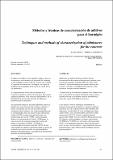Por favor, use este identificador para citar o enlazar a este item:
http://hdl.handle.net/10261/25878COMPARTIR / EXPORTAR:
 SHARE SHARE
 CORE
BASE CORE
BASE
|
|
| Visualizar otros formatos: MARC | Dublin Core | RDF | ORE | MODS | METS | DIDL | DATACITE | |

| Título: | Métodos y técnicas de caracterización de aditivos para el hormigón |
Otros títulos: | Techniques and methods of characterization of admixtures for the concrete | Autor: | Palacios, Magdalena; Sierra Sánchez, Carlos José CSIC; Puertas, Francisca CSIC ORCID | Palabras clave: | Aditivos Técnicas y métodos de caracterización Admixtures Techniques and methods of characterization |
Fecha de publicación: | 30-mar-2003 | Editor: | Consejo Superior de Investigaciones Científicas (España) | Citación: | Materiales de Construcción 53(269): 89-105 (2003) | Resumen: | [ES] Se definen los aditivos como aquellos productos que son incorporados en el momento del amasado del hormigón en una cantidad no mayor del 5% en masa, con relación al contenido de cemento en el hormigón, con objeto de modificar las propiedades de la mezcla en estado fresco y/o endurecido. El comportamiento de los aditivos depende de su composición química e iónica, de los grupos funcionales orgánicos presentes, de la estructura del polímero y de la distribución de pesos moleculares de los diferentes polímeros que lo constituyen. En el presente trabajo se describen diferentes técnicas y métodos de caracterización físico-química, química e iónica, estructural, así como de los polímeros que constituyen dichos aditivos. Las técnicas empleadas son: la cromatografía iónica, la espectroscopia ultravioleta visible (UV-VIS), la espectroscopia infrarroja con transformada de Fourier (FTIR), la espectroscopia Raman con transformada de Fourier (FT-Raman), la espectroscopia de resonancia magnética nuclear de protón y de carbono (1CH-RMN, 13C-RMN), la cromatografía de exclusión molecular (GPC). Se han seleccionado dos aditivos comerciales sobre los que se ha realizado esta caracterización, un superplastificante basado en policarboxilatos, y un reductor de la retracción derivado de polipropilenglicol. [EN] Admixtures are defined as those products that are incorporated in the moment of the process of mixture of the concrete in a quantity not bigger than 5 by mass of the cement %, with relationship to the cement content in the concrete, with object of modifying the properties of the mixture in .state fresh and/or hardened. The behaviour of the admixtures depends on its chemical and ionic composition, the organic functional groups present, and the structure of the polymer and the distribution of molecular weight of the different polymers. In the present work the techniques and methods of characterization physical-chemistry, chemistry and ionic, structural, as well as of the polymers that constitute this admixtures, are described. A lot of techniques have been employed like: ionic chromatography, ultraviolet-visible spectroscopy (UV-VIS), Fourier transform infrared spectroscopy (FTIR), Fourier transform Raman spectroscopy (FT-Raman), nuclear magnetic resonance spectroscopy (1H-RMN and 13C-RMN), gel permeation chromatography (GPC). Two commercial admixtures have been selected to carry out this characterization, a superplastificant based on policarboxilates, and a reducer of the shrinkage based on polipropilenglycol. |
Descripción: | 18 páginas, 21 figuras, 7 tablas. | Versión del editor: | http://dx.doi.org/10.3989/mc.2003.v53.i269.262 | URI: | http://hdl.handle.net/10261/25878 | DOI: | 10.3989/mc.2003.v53.i269.262 | ISSN: | 0465-2746 | E-ISSN: | 1988-3226 |
| Aparece en las colecciones: | (IETCC) Artículos |
Ficheros en este ítem:
| Fichero | Descripción | Tamaño | Formato | |
|---|---|---|---|---|
| 353.pdf | 2,34 MB | Adobe PDF |  Visualizar/Abrir |
CORE Recommender
SCOPUSTM
Citations
19
checked on 12-abr-2024
Page view(s)
1.663
checked on 19-abr-2024
Download(s)
799
checked on 19-abr-2024
Google ScholarTM
Check
Altmetric
Altmetric
NOTA: Los ítems de Digital.CSIC están protegidos por copyright, con todos los derechos reservados, a menos que se indique lo contrario.
